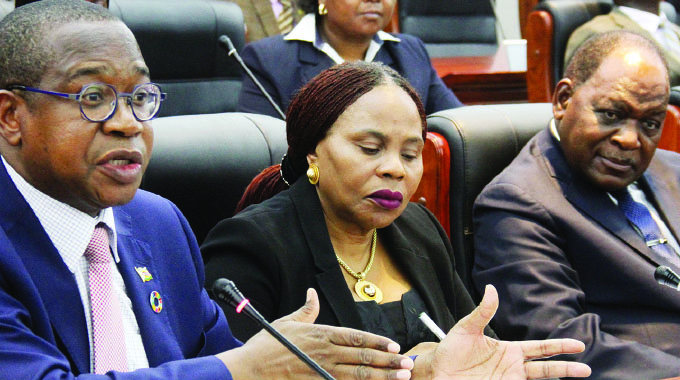
26th February, 2020
- Maize Producer Floor Price for the Remainder of the 2019-2020 Marketing Season
Cabinet considered and approved the maize producer floor price for the remainder of the 2019-2020 marketing season as presented by the Minister of Lands, Agriculture, Water and Rural Resettlement as Acting Chairman of the Cabinet Committee on Food Security and Nutrition (CFSN). Cabinet agreed as follows:
- a) that the maize floor producer price be reviewed to ZW$6 958 per metric tonne to encourage deliveries to the Grain Marketing Board (GMB) and for the replenishment of the Strategic Grain Reserve; and
- b) that the floor price of traditional grains be pegged at ZW$7 260 per metric tonne for the 2019-2020 marketing
Traditional grains are what is being commonly referred to by the media as small grains, which in essence is a term inherited from the colonial era when traditional grains had no significant role to play in the agricultural economy.
Therefore, the use of the term “small grains” should be discontinued and discouraged as we begin to promote traditional grains in the face of climate change challenges, and health challenges related to consumption of maize meal. As Government invests in the production of traditional grains such as millet, rapoko, sorghum as well as research related to their development, we cannot continue to use the term “small grains”.
- Maize, Wheat and Soyabean
Production Recovery Plan
Cabinet considered and approved the maize, wheat and soyabean production recovery plan. The recovery plan is an extract of the Agriculture and Food Systems Transformation Strategy, which seeks to achieve over US$8 billion Gross Agriculture Production Value by 2023. The recovery plan is anchored on the following strategic interventions:
Financial services sector-led commercial contract farming programme which will target 5 000 highly productive farmers in irrigated areas and promoting conservation agriculture and crop diversity;
The Commodity Value Chain Financing Model whereby all private sector players that get raw materials directly from agriculture are compelled to support and produce up to 40 percent of their requirements locally through contract farming backward integration;
Climate-proofed Presidential Input Support Scheme (pfumvudza) which will support 1,6 million vulnerable households to produce maize with a standardised input package of 5kg seed; 50kg basal and 50kg top dressing fertiliser;
Pre-planting producer price announcement as it has a bearing on planting and crop management decisions;
Creation of a Lowveld Maize Belt (Masvingo, Bulawayo Kraal and Kanyemba), where the country can enjoy two maize cycles per year;
Speeding up irrigation development programmes;
Embarking on the capacitation of the Extension Services Delivery Programme which will entail increased mobility, appropriate training and equipping with digital technologies for effective backstopping and coaching of farmers;
The innovation and modernisation of agriculture, resulting in the effective use of modern and smart technologies in the agriculture sector.
Cabinet acknowledged that the Maize, Wheat and Soyabean Recovery Plan, if meticulously implemented, has the potential to reverse the dependence on imports for these crops as well as to mitigate the financial burden on Treasury and ultimately put the country on a trajectory to attain Vision 2030.
- Proposed Zimbabwe Investment Guide
Cabinet considered and approved the Zimbabwe Investment Guide as presented by the Minister of Finance and Economic Development. The Guide is a facilitative tool to the implementation of the new National Investment Policy in the wake of the promulgation of the Zimbabwe Investment and Development Agency (ZIDA) Act. It outlines, inter-alia, the country’s investment opportunities, the tax system and investment incentives. Government will periodically review the Investment Guide to ensure that investors remain current with regard to Zimbabwe’s investment requirements and incentives.
- Proposed Civil Service Mutual Savings Fund
Following presentation by the Minister of Finance and Economic Development of the proposed Civil Service Mutual Savings Fund, Cabinet resolved as follows:
- a) that the Government Employees Mutual Savings Fund (GEMS Fund) be established with effect from March, 2020;
- b) that Government will immediately provide a lump sum injection of ZW$100 million from the Budget to facilitate the expedited establishment of the Fund;
- c) that a 2½ percent of the total remuneration be deducted from every Government employee in consultation with the Public Service Commission;
- d) that a Steering Committee comprising the Public Service Commission, Ministry of Finance and Economic Development; and the Office of the President and Cabinet be established to decide on the implementation modalities of the Fund; and
- e) that Garrison Shops be established to enable all members of the defence forces who will be on the GEMS Fund to have the additional benefit of accessing subsidised basic commodities that would be sold in the specialised shops located within cantonment areas.
- National Preparedness and Response Progress Regarding the 2019 Novel Coronavirus (COVID-19) Outbreak.
The Minister of Health and Child Care updated Cabinet on the country’s preparedness and response progress regarding the 2019 novel coronavirus.
He indicated that his ministry continues to follow up travellers to Zimbabwe who visited China and other affected countries, guided by the World Health Organisation (WHO) Risk Assessment Tool.
As of 23 February, a total of 4 589 travellers have been screened at our air and ground ports of entry.
A suspected case that was admitted to Wilkins Infectious Diseases Hospital was discharged on 20 February 2020 after testing negative for the virus.
She is now at home and will continue on the 21-day follow-up and surveillance before her self-quarantine can be lifted.
Following reports that some people from affected countries were violating self-quarantine conditions set by Government, Cabinet approved that the Ministry of Health and Child Care should intensify spot checks and enforce immediate detention and isolation of anyone who violates the said regulations.
